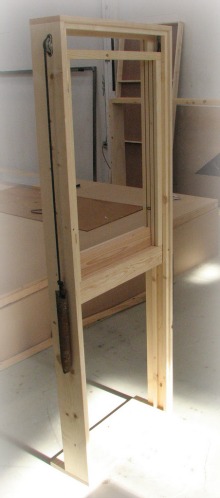Double Hung Window
With Counterweights
I first encountered a double hung window with counterweights in a 1920's house I renovated.
If your house is of a certain age it was probably built with counterweighted windows. Double hung windows are where there is a top window and a bottom window and both can slide up and down, so that you can either open up a space at the top or at the bottom.

They are called double hung because you have hung, or installed, two windows working in tandem. Each has its own track and they move separately, but each seals against the other when they are closed.
Gravity being what it is there has to be a mechanism to keep the windows up, when you want them up. Modern windows do this with springs and friction on the sides. I don’t know when it started, but back in the day the modern way to keep a window open was with counterweights. A counterweighted double hung window would allow either window to stay in any position.
At the top of the window track there would be a pulley. A cord, called a sash cord, would run from the window, over the pulley, to a window counterweight. There would be a similar pulley on each side of the window, so that the would hang centered and not bind in the track. The weights were hidden behind wood molding, so you would never see them.
This system allowed you to open a gap at the top and the bottom to promote circulation in the room. In the age before AC this was great. This worked with those windows that were truly double hung windows, but some sash windows had the top window fixed in place. These saved money, but lacked the benefit just described. The photo shown is an example of this type of sash window. CChauvet at Flickr took this photo of a sash window in the making. Here it is pictured with the lower window almost all the way up, but there is no sash counterweight for the top window, which cannot move.
The system worked very well, except that the sash cords would eventually rot and break, and then your window would be hard to open and would not stay open. The cords would last for several decades, but when they broke they were a pain to fix because you had to pry off the molding to get to the weight, and partially disassemble the window to be able to replace the cord. Some windows made it easier by including an access panel to allow you to easily remove the counterweight.
Whether it was an easy job or a difficult job depended upon the window and the skills of the homeowner. I have fixed a fair number of these, and once you learned the idiosyncrasies of the job it could go fairly quickly.
However, these windows are inefficient with regards to heat loss. The counterweights require an open shaft, and this area can’t be insulated. Plus, these windows tended to be single pane and have small air gaps around the window to allow them to slide up and down.
If you have old, counterweighted double-hung windows you should consider replacing them with modern, insulated, double-hung windows. There will be much less heat loss.
These have two advantages. They avoid the heat loss through the counterweight box, and they are double pane windows, so there is less heat lost through the glass.
When we replaced our old double hung windows, in 1998 or so, we received quotes that ranged from around $10,000 to $20,000. Part of that was differences in quality, and part of it was contractors trying to maximize their profits. Since my wallet was too thin to allow them a large profit margin I had to negotiate the price down. It is a highly competitive market. You should be able to negotiate a better price.
We replaced all of our old double hung windows at once, but I have known people to do this one at a time. This allows you to pay as you go, but be careful to do it in a way that you can make sure your windows match. If you are getting a good deal on a double hung, double pane window, but there are two windows side-by-side, I suggest you replace both together. You may not get as good a deal next time.
To the mechanically-minded there is a charm to the counterweighted double-hung windows. If I was living in paradise, where it was always 70 degrees, I would not replace these. Since I live in Ohio I consider the upgrade to modern double pane windows to have been one of my better investments in my house.
To Top of Page - Double Hung Window
To Fenestration (part 2 of Window Placement)
To Window Materials and Window Replacements
Home - House Design
Please!




New! Comments
Have your say about what you just read! Leave me a comment in the box below.